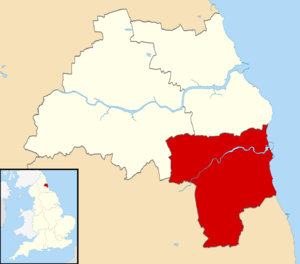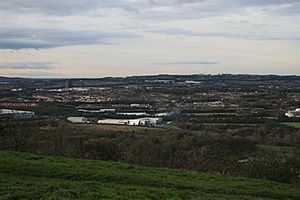City of Sunderland facts for kids
Quick facts for kids
City of Sunderland
|
||
|---|---|---|

Sunderland White Lighthouse
|
||
|
||
| Motto(s): | ||

Sunderland shown within Tyne and Wear
|
||
| Sovereign state | United Kingdom | |
| Country | England | |
| Region | North East | |
| Ceremonial county | Tyne and Wear | |
| City region | North East | |
| Metropolitan borough | 1 April 1974 | |
| City status | 20 May 1992 | |
| Named for | Sunderland | |
| Administrative HQ | City Hall, Sunderland | |
| Government | ||
| • Type | Metropolitan borough | |
| • Body | Sunderland City Council | |
| Area | ||
| • Total | 53.1 sq mi (137.4 km2) | |
| Area rank | 195th | |
| Population
(2005 est.)
|
||
| • Total | 277,705 | |
| • Rank | 53rd | |
| Demonym(s) | Mackem (colloq.) | |
| Ethnicity (2021) | ||
| • Ethnic groups |
List
|
|
| Religion (2021) | ||
| • Religion |
List
53.2% Christianity
39.5% no religion 1.8% Islam 0.3% Sikhism 0.2% Hinduism 0.2% Buddhism 0.0% Judaism 0.3% other 4.5% not stated |
|
| Time zone | UTC+0 (GMT) | |
| • Summer (DST) | UTC+1 (BST) | |
| Postcode area |
|
|
| Dialling code | 0191 | |
| ISO 3166 code | GB-SND | |
| GSS code | E08000024 | |
Sunderland is a big area in Tyne and Wear, England. It's known as the City of Sunderland. It's called a metropolitan borough, which is like a large local government area.
The city is named after its biggest town, Sunderland. But the City of Sunderland covers a much larger area. It includes other towns like Washington, Hetton-le-Hole, and Houghton-le-Spring. It also has many smaller villages and hamlets.
This area was officially created in 1974. It brought together several smaller districts from County Durham. In 1992, Sunderland was given "city status" by Queen Elizabeth II. This was a special honour during her 40th year as Queen. In 2011, the area had about 575,400 people living there. Most of them (around 274,286) lived in the main town of Sunderland. This makes Sunderland the largest town in the North East of England.
Contents
History of Sunderland City

The City of Sunderland was formed in 1974. This happened because of a law called the Local Government Act 1972. It combined several areas from County Durham. These included Washington Urban District, Houghton-le-Spring Urban District, and Hetton Urban District. They joined with the County Borough of Sunderland.
Sunderland became a city on May 20, 1992. This was part of the celebrations for the Queen's 40th year on the throne. Even though Sunderland doesn't have a cathedral, it does have Sunderland Minster. Cathedrals are usually found in cities, but Sunderland is part of the Diocese of Durham.
For many years, Sunderland was famous for building ships. Between 1939 and 1945, during World War II, the shipyards on the River Wear built a huge number of merchant ships. They made about a quarter of all the merchant ships in the UK during that time. However, by the end of the 20th century, there was less demand for ships built in Sunderland. The last shipyard closed in 1988.
In 2004, Saint Benedict Biscop was chosen as the city's patron saint.
Sunderland's Twin Towns
Sunderland has special connections with other cities around the world. These are called "twin towns" or "friendship agreements." Sunderland is twinned with two cities in Europe:
- Essen, Germany
- Saint-Nazaire, France
It also has friendship agreements with cities in other countries:
- Washington, D.C., USA
- Harbin, China
- Nanjing, China
Sunderland and Washington, D.C., have a cool historical link. The family of George Washington, the first President of the USA, used to live in Washington Old Hall. This historic house is actually within Sunderland's boundaries.
Sunderland's Unique Dialect
People from Sunderland often speak with a special accent and dialect called "Mackem." Sometimes, people who aren't from the area might confuse it with the "Geordie" accent. Geordie is spoken in nearby Newcastle upon Tyne. Both accents sound a bit similar.
The Mackem dialect can even change slightly in different parts of Sunderland. This was shown when some fake tapes were made during the search for the "Yorkshire Ripper." Experts thought the person on the tapes, known as Wearside Jack, was from the Castletown area of Sunderland. When the person, John Humble, was caught, he confirmed he went to school in Castletown as a child.
Sunderland's Culture and Arts
Art and Literature in Sunderland
The famous writer Lewis Carroll, who wrote Alice in Wonderland, often visited the Sunderland area. He wrote much of his poem Jabberwocky and "The Walrus and the Carpenter" while staying in Whitburn. Some people believe that places like Hylton Castle and Backhouse Park in the area inspired parts of his Alice in Wonderland stories. There's even a statue of Carroll in Whitburn library.
A graphic novel called Alice in Sunderland by Bryan Talbot explores Carroll's connection to the city. More recently, Terry Deary, who wrote the popular Horrible Histories books, is from Sunderland.
The painter L. S. Lowry also visited Sunderland often. He stayed at the Seaburn Hotel. Many of his paintings show scenes of the sea and shipbuilding from the River Wear. You can see exhibitions at the Northern Gallery for Contemporary Art and the Sunderland Museum and Winter Gardens. The museum has many of Lowry's works. The National Glass Centre also displays beautiful glass sculptures.
Music Scene in Sunderland
Sunderland has produced several musicians who became famous worldwide. One of the most well-known is Dave Stewart from the band Eurythmics. The band Kenickie, with Lauren Laverne as lead singer, also had a top ten album in the 1990s.
In recent years, Sunderland has had a growing music scene. Bands like Smalltown Heroes, The futureheads, Field Music, and Frankie & The Heartstrings have gained national attention.
Other famous musicians from Sunderland include the punk band The Toy Dolls, who had a hit with "Nellie the Elephant" in 1984. Ruth Ann Boyle, the lead singer of Olive, had a number one hit with "You're Not Alone" in 1997.
In 2005, Sunderland hosted BBC Radio 1's Big Weekend concert. This was a huge free music festival at Herrington Country Park. About 30,000 people came to see bands like Foo Fighters, Kasabian, and The Black Eyed Peas.
The Sunderland Empire Theatre also hosts music acts. Since 2009, the Stadium of Light has held big concerts. Famous bands like Oasis, Take That, and Coldplay have performed there.
Theatre in Sunderland
The Sunderland Empire Theatre opened in 1907. It's the biggest theatre in the North East of England. After a big renovation in 2004, it can now host large West End shows. Musicals like Miss Saigon and Starlight Express have been performed there. The Empire is the only theatre between Leeds and Glasgow that can fit such big productions.
The Royalty Theatre is home to an amateur theatre group. They put on many smaller shows throughout the year. The famous film producer David Parfitt used to be part of this group. He is now a supporter of the theatre.
The Empire Theatre was also where the comedian Sid James gave his last performance in 1976. He sadly passed away on stage.
Sunderland's Economy
Sunderland is home to a large Nissan car manufacturing plant. This factory builds many cars.
The city centre of Sunderland has been updated in recent years. The Sunniside area now has new bars, cafes, and shops. It also includes an Empire Cinema and a Gala Casino.
The Bridges Shopping Centre is a big shopping mall in the city centre. It opened in 1988 and gets over 26 million visitors every year.
Media and Technology in Sunderland
Sunderland has two local newspapers. The Sunderland Echo is a daily evening paper that started in 1873. The Sunderland Star is a free newspaper.
The city also has its own community radio station, Spark Sunderland. There's also a hospital radio station called Radio Sunderland for Hospitals. Sunderland is covered by regional TV channels like BBC North East and Cumbria and ITV Tyne Tees.
In 2010, the BBC called Sunderland "The Facebook Capital of Britain." This was because people in Sunderland were more likely to use Facebook than anywhere else in the UK.
Sports in Sunderland
The most famous sports team in Sunderland is the football team, Sunderland A.F.C.. The club was formed in 1879. They play their home games at the Stadium of Light, which can hold 49,000 fans.
Sunderland also has a top women's football team, Sunderland A.F.C. Women. They play in the highest league for women's football in England.
For many years, Sunderland A.F.C. played at Roker Park. But in 1997, they moved to the new Stadium of Light. This stadium was built on the site of an old coal mine.
Besides the main football club, Sunderland also has a non-league team called Sunderland Ryhope Community Association F.C.. They play in the Northern League Division One. Washington F.C. is another football club from the Washington area of the city.
People from Sunderland
See also
 In Spanish: Sunderland para niños
In Spanish: Sunderland para niños





